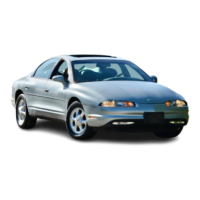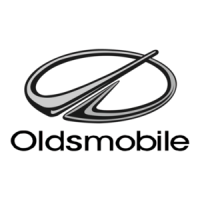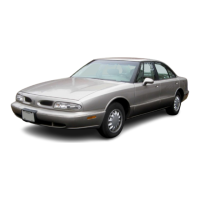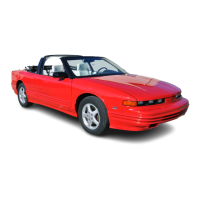Do you have a question about the Oldsmobile 1997 88 and is the answer not in the manual?
Information about adjusting seats, reclining seatbacks, and head restraints.
How to use safety belts properly and what not to do with them.
Proper adult usage of safety belts and related considerations for children.
Details the driver's restraint system and how to wear the lap-shoulder belt correctly.
Explains the mechanics and effectiveness of safety belts in preventing injuries during accidents.
Addresses common queries about safety belts, including entrapment and interaction with airbags.
Instructions on adjusting the shoulder belt height for optimal driver and passenger safety.
Guidance on proper safety belt usage for pregnant women to ensure safety for both mother and fetus.
Details on using the right front passenger's safety belt and child restraint locking features.
Explanation of the Supplemental Restraint System (SRS), commonly known as the air bag system.
Emphasizes the necessity of child restraints for all children, regardless of size or travel distance.
Discusses different types of add-on child restraints and selection criteria.
Recommends rear seat placement for child restraints due to airbag risks in the front.
Guidance for children who have outgrown child restraints, emphasizing proper vehicle safety belt use.
Information on obtaining and using safety belt extenders when the standard belt is too short.
Information about ignition and door keys, including key tags and theft prevention features.
Details on manual and power door locks, including safety features and locking/unlocking methods.
How to program automatic door lock features and customize modes for convenience.
Explanation of the delayed locking feature, allowing time to exit before doors automatically lock.
Describes the rear door security locks designed to prevent passengers from opening rear doors from inside.
How to use the remote lock control transmitter for locking/unlocking doors and trunk.
Details on remote lock control operations like unlocking, locking, and trunk release.
How to activate the instant alarm feature using the remote transmitter for security.
Overview of programmable features for remote lock control transmitters, including auto locks and security feedback.
Instructions for replacing the battery in the remote lock control transmitter, including proper handling.
How to use the remote trunk release and the lockout feature for securing trunk contents.
Information on vehicle theft prevention, key security, and parking safety tips.
Explanation of the PASS-Key II passive theft-deterrent system and how it works.
Guidelines for the initial break-in period of a new vehicle to ensure optimal performance.
Description of the five ignition switch positions and their functions, including accessory and starting modes.
Procedures for starting the engine, including safety features and what to do if the engine doesn't start.
Explanation of the automatic transaxle shift lever positions and their functions.
Instructions on how to set and release the parking brake, and warnings about driving with it engaged.
Steps for safely shifting into PARK, emphasizing brake application and parking brake engagement.
Information on engine exhaust hazards, carbon monoxide risks, and signs of exhaust leaks.
Overview of power window controls on the driver's armrest and individual door controls.
How to use the turn signal lever for signaling turns and lane changes, including automatic return.
How to turn on headlamps, parking lamps, sidemarker lamps, taillamps, and instrument panel lights.
Function and operation of Daytime Running Lamps (DRL) for enhanced visibility.
How to operate fog lamps, noting they require headlamps or parking lamps to be on.
How the twilight sentinel feature controls headlamp operation based on exterior light levels.
How interior lamps turn on automatically when doors are opened for easier entry and exit.
How to adjust mirrors and use features like day-night adjustment and compass.
Details on map pockets, glove box, and front armrest storage areas.
Overview of the instrument panel layout and its various components.
Introduction to warning lights and gages that signal vehicle problems and the importance of paying attention to them.
How the air bag readiness light indicates system status and potential malfunctions.
How the coolant temperature gauge indicates engine temperature and what to do if it overheats.
Explanation of the Check Engine light and its role in monitoring emissions and engine performance.
Explanation of the climate control system, including mode knob and temperature controls.
How to use the rear window defogger to clear condensation or frost.
How the flow-through ventilation system supplies outside air into the vehicle.
Introduction to the Delco Electronics audio system and how to get the most enjoyment from it.
Steps for setting the vehicle's clock using the HR and MN buttons.
How to turn the audio system on/off and adjust volume using the PWR-VOL knob.
How to find radio stations using AM-FM selection, TUNE knob, SEEK, and SCAN functions.
How to adjust Bass and Treble settings for the audio system.
Guidelines for playing cassette tapes, including insertion and troubleshooting.
Instructions for inserting and playing compact discs, including track selection and error messages.
How the THEFTLOCK feature deters radio theft by disabling functionality when battery power is removed.
Step-by-step instructions for activating the THEFTLOCK system by setting a secret code.
How to maintain the cassette tape player for optimal sound quality and prevent damage.
Proper handling and storage of compact discs to prevent damage and ensure playback quality.
Instructions for cleaning and maintaining the power antenna mast, including car wash precautions.
Principles of defensive driving, emphasizing being prepared for unexpected actions from other drivers.
The dangers of drinking and driving, its effects on driving abilities, and legal limits.
Overview of the three main systems controlling vehicle movement: brakes, steering, and accelerator.
Explanation of braking action, perception/reaction time, and factors affecting stopping distance.
How the Anti-Lock Braking System (ABS) helps prevent braking skids and its normal operation checks.
How the traction control system limits wheel spin, especially on slippery surfaces.
How power steering works and what happens if assist is lost.
When steering is more effective than braking for evasive maneuvers in emergencies.
Steps for safely recovering the vehicle if its wheels drop off the road onto the shoulder.
Tips for safely passing other vehicles on two-lane highways, emphasizing visibility and judgment.
Types of skids (braking, steering, acceleration) and how to handle them.
Hazards and tips for safe night driving, including visibility and driver impairment.
How wet roads affect traction and visibility, and tips for driving safely in rain.
Explanation of hydroplaning, its causes (tread depth, speed), and advice to slow down in rain.
Strategies for safe city driving, including route planning and traffic signal awareness.
Rules and advice for freeway driving, including merging, lane usage, and exit procedures.
Checklist of items to inspect and prepare before embarking on a long trip for vehicle readiness and safety.
Description of highway hypnosis, its causes, and tips to prevent drowsiness while driving.
Specific driving considerations for navigating steep hills and mountain roads.
Tips for preparing the vehicle and driving safely during winter conditions.
How snow and ice affect traction and driving techniques, including the use of traction control.
Advice for staying safe and seeking help if stranded in a blizzard, including hazard flashers and vehicle preparation.
Information on vehicle weight limits, tire loading, and proper cargo distribution.
Cautions and requirements for safely towing a trailer, including proper equipment and driving techniques.
How to use hazard warning flashers to alert others and signal a vehicle problem.
Step-by-step instructions for safely jump-starting a vehicle with a dead battery using another vehicle.
Recommendations for professional towing services and information to provide to the towing company.
How to recognize engine overheating and immediate steps to take, including safety precautions for steam.
Identification of key cooling system components under the hood and safety precautions.
What to expect and do if a tire fails, including procedures for front and rear tire blowouts.
Safety precautions and steps for changing a flat tire on a level surface.
Information about the compact spare tire, its inflation pressure, speed/distance limitations, and replacement.
Advice on getting unstuck, emphasizing avoiding wheel spin and using caution.
Importance of using genuine GM parts and trained service personnel for vehicle maintenance.
Advice for performing DIY service, emphasizing the use of service manuals and safety precautions.
Recommended gasoline octane rating and specifications for optimal vehicle performance.
How to open the fuel door and remove the fuel filler cap safely.
Importance of checking engine oil levels, indicated by the CHECK OIL light.
How to identify recommended engine oils using the API Starburst symbol and proper viscosity grades.
Location and procedure for checking and replacing the air cleaner filter.
When to check and change automatic transaxle fluid and filter, especially under severe conditions.
Information about the DEX-COOL engine coolant, its properties, and mixing instructions.
When to check power steering fluid and how to do it, along with warnings about fluid loss.
What to use for windshield washer fluid and cautions regarding mixing concentrates or using engine coolant.
Information about brake fluid, its purpose, and why topping off is not recommended.
How to identify worn brake pads through warning sounds and the importance of timely brake service.
General procedure for replacing headlamp bulbs and advice to contact the retailer for unlisted procedures.
Information about the vehicle's high-quality tires and where to get service information.
How to check tire pressure using the Tire-Loading Information label and pocket-type gauges.
Importance of tire rotation for uniform wear and alignment checks.
How to identify when tires need replacement based on treadwear indicators and damage.
Explanation of the Uniform Tire Quality Grading system for treadwear, traction, and temperature performance.
When to replace wheels, bolts, and nuts, and the importance of using genuine GM parts.
General precautions for using cleaning products and safety tips.
Tips for cleaning interior surfaces like vinyl, leather, and carpet using vacuum cleaners and specific cleaners.
How to clean the windshield and wiper blades for optimal performance.
Importance of washing the vehicle often to preserve its finish, with tips on washing techniques.
Occasional waxing and polishing to maintain paint finish, and using GM-approved products.
How to clean aluminum and chrome wheels, avoiding harsh chemicals and abrasive brushes.
Importance of anti-corrosion material application during sheet metal repair or replacement.
Importance of flushing the underbody with water to remove corrosive materials from ice and snow removal.
How fuses and circuit breakers protect vehicle wiring circuits from electrical problems.
A chart detailing the usage of fuses in the driver's side fuse block.
Location of additional fuses and how to access them, recommending retailer assistance due to difficulty.
A list of common bulb types and their part numbers for exterior and interior lamps.
Approximate capacities for various vehicle fluids and specifications like engine displacement and horsepower.
Key engine specifications for the 3800 Series II engine, including VIN code and horsepower.
How proper vehicle maintenance contributes to environmental protection and vehicle condition.
Overview of the five parts of the maintenance section and what each covers.
Explanation of how to use the maintenance schedule and the importance of GM-trained service.
Guidance on determining the correct maintenance schedule based on driving habits and conditions.
How to choose between the Short Trip/City and Long Trip/Highway maintenance schedules.
Maintenance schedule entries for short trips and city driving up to 100,000 miles.
Explanation of the Long Trip/Highway schedule and its footnotes.
Owner checks and services to be performed at specified intervals for safety and vehicle condition.
Underhood checks recommended at each fuel fill, including engine oil and coolant levels.
Monthly checks including tire inflation and cassette deck service.
Semi-annual checks including restraint systems and wiper blades.
How to check automatic transaxle fluid level and identify potential problems.
How to check the starter switch function in park or neutral gears and safety precautions.
How to check the BTSI system to ensure it prevents shifting out of PARK without brake application.
Inspections and services to be performed at least twice a year by a retailer or qualified service center.
Inspecting steering, suspension, and drive axle components for damage, wear, or leaks.
Inspecting the entire brake system, including lines, pads, linings, and parking brake adjustment.
List of recommended fluids and lubricants for vehicle maintenance, including part numbers and specifications.
A section to record maintenance performed, including date, odometer reading, and service provider.
Steps to follow to resolve customer concerns if they are not adequately addressed at the retail facility level.
How TTY users can communicate with Oldsmobile for assistance via text telephone.
Overview of the Oldsmobile Roadside Assistance program, its availability, and services provided.
Details on the roadside assistance program for vehicles purchased in Canada.
How Courtesy Transportation helps customers stay mobile during warranty service, including loaner cars or reimbursement.
Information about the BBB AUTO LINE program for settling automotive disputes.
How to report vehicle safety defects to NHTSA and the investigation process.
How to report vehicle safety defects to Transport Canada and General Motors Canada.
Information about adjusting seats, reclining seatbacks, and head restraints.
How to use safety belts properly and what not to do with them.
Proper adult usage of safety belts and related considerations for children.
Details the driver's restraint system and how to wear the lap-shoulder belt correctly.
Explains the mechanics and effectiveness of safety belts in preventing injuries during accidents.
Addresses common queries about safety belts, including entrapment and interaction with airbags.
Instructions on adjusting the shoulder belt height for optimal driver and passenger safety.
Guidance on proper safety belt usage for pregnant women to ensure safety for both mother and fetus.
Details on using the right front passenger's safety belt and child restraint locking features.
Explanation of the Supplemental Restraint System (SRS), commonly known as the air bag system.
Emphasizes the necessity of child restraints for all children, regardless of size or travel distance.
Discusses different types of add-on child restraints and selection criteria.
Recommends rear seat placement for child restraints due to airbag risks in the front.
Guidance for children who have outgrown child restraints, emphasizing proper vehicle safety belt use.
Information on obtaining and using safety belt extenders when the standard belt is too short.
Information about ignition and door keys, including key tags and theft prevention features.
Details on manual and power door locks, including safety features and locking/unlocking methods.
How to program automatic door lock features and customize modes for convenience.
Explanation of the delayed locking feature, allowing time to exit before doors automatically lock.
Describes the rear door security locks designed to prevent passengers from opening rear doors from inside.
How to use the remote lock control transmitter for locking/unlocking doors and trunk.
Details on remote lock control operations like unlocking, locking, and trunk release.
How to activate the instant alarm feature using the remote transmitter for security.
Overview of programmable features for remote lock control transmitters, including auto locks and security feedback.
Instructions for replacing the battery in the remote lock control transmitter, including proper handling.
How to use the remote trunk release and the lockout feature for securing trunk contents.
Information on vehicle theft prevention, key security, and parking safety tips.
Explanation of the PASS-Key II passive theft-deterrent system and how it works.
Guidelines for the initial break-in period of a new vehicle to ensure optimal performance.
Description of the five ignition switch positions and their functions, including accessory and starting modes.
Procedures for starting the engine, including safety features and what to do if the engine doesn't start.
Explanation of the automatic transaxle shift lever positions and their functions.
Instructions on how to set and release the parking brake, and warnings about driving with it engaged.
Steps for safely shifting into PARK, emphasizing brake application and parking brake engagement.
Information on engine exhaust hazards, carbon monoxide risks, and signs of exhaust leaks.
Overview of power window controls on the driver's armrest and individual door controls.
How to use the turn signal lever for signaling turns and lane changes, including automatic return.
How to turn on headlamps, parking lamps, sidemarker lamps, taillamps, and instrument panel lights.
Function and operation of Daytime Running Lamps (DRL) for enhanced visibility.
How to operate fog lamps, noting they require headlamps or parking lamps to be on.
How the twilight sentinel feature controls headlamp operation based on exterior light levels.
How interior lamps turn on automatically when doors are opened for easier entry and exit.
How to adjust mirrors and use features like day-night adjustment and compass.
Details on map pockets, glove box, and front armrest storage areas.
Overview of the instrument panel layout and its various components.
Introduction to warning lights and gages that signal vehicle problems and the importance of paying attention to them.
How the air bag readiness light indicates system status and potential malfunctions.
How the coolant temperature gauge indicates engine temperature and what to do if it overheats.
Explanation of the Check Engine light and its role in monitoring emissions and engine performance.
Explanation of the climate control system, including mode knob and temperature controls.
How to use the rear window defogger to clear condensation or frost.
How the flow-through ventilation system supplies outside air into the vehicle.
Introduction to the Delco Electronics audio system and how to get the most enjoyment from it.
Steps for setting the vehicle's clock using the HR and MN buttons.
How to turn the audio system on/off and adjust volume using the PWR-VOL knob.
How to find radio stations using AM-FM selection, TUNE knob, SEEK, and SCAN functions.
How to adjust Bass and Treble settings for the audio system.
Guidelines for playing cassette tapes, including insertion and troubleshooting.
Instructions for inserting and playing compact discs, including track selection and error messages.
How the THEFTLOCK feature deters radio theft by disabling functionality when battery power is removed.
Step-by-step instructions for activating the THEFTLOCK system by setting a secret code.
How to maintain the cassette tape player for optimal sound quality and prevent damage.
Proper handling and storage of compact discs to prevent damage and ensure playback quality.
Instructions for cleaning and maintaining the power antenna mast, including car wash precautions.
Principles of defensive driving, emphasizing being prepared for unexpected actions from other drivers.
The dangers of drinking and driving, its effects on driving abilities, and legal limits.
Overview of the three main systems controlling vehicle movement: brakes, steering, and accelerator.
Explanation of braking action, perception/reaction time, and factors affecting stopping distance.
How the Anti-Lock Braking System (ABS) helps prevent braking skids and its normal operation checks.
How the traction control system limits wheel spin, especially on slippery surfaces.
How power steering works and what happens if assist is lost.
When steering is more effective than braking for evasive maneuvers in emergencies.
Steps for safely recovering the vehicle if its wheels drop off the road onto the shoulder.
Tips for safely passing other vehicles on two-lane highways, emphasizing visibility and judgment.
Types of skids (braking, steering, acceleration) and how to handle them.
Hazards and tips for safe night driving, including visibility and driver impairment.
How wet roads affect traction and visibility, and tips for driving safely in rain.
Explanation of hydroplaning, its causes (tread depth, speed), and advice to slow down in rain.
Strategies for safe city driving, including route planning and traffic signal awareness.
Rules and advice for freeway driving, including merging, lane usage, and exit procedures.
Checklist of items to inspect and prepare before embarking on a long trip for vehicle readiness and safety.
Description of highway hypnosis, its causes, and tips to prevent drowsiness while driving.
Specific driving considerations for navigating steep hills and mountain roads.
Tips for preparing the vehicle and driving safely during winter conditions.
How snow and ice affect traction and driving techniques, including the use of traction control.
Advice for staying safe and seeking help if stranded in a blizzard, including hazard flashers and vehicle preparation.
Information on vehicle weight limits, tire loading, and proper cargo distribution.
Cautions and requirements for safely towing a trailer, including proper equipment and driving techniques.
How to use hazard warning flashers to alert others and signal a vehicle problem.
Step-by-step instructions for safely jump-starting a vehicle with a dead battery using another vehicle.
Recommendations for professional towing services and information to provide to the towing company.
How to recognize engine overheating and immediate steps to take, including safety precautions for steam.
Identification of key cooling system components under the hood and safety precautions.
What to expect and do if a tire fails, including procedures for front and rear tire blowouts.
Safety precautions and steps for changing a flat tire on a level surface.
Information about the compact spare tire, its inflation pressure, speed/distance limitations, and replacement.
Advice on getting unstuck, emphasizing avoiding wheel spin and using caution.
Importance of using genuine GM parts and trained service personnel for vehicle maintenance.
Advice for performing DIY service, emphasizing the use of service manuals and safety precautions.
Recommended gasoline octane rating and specifications for optimal vehicle performance.
How to open the fuel door and remove the fuel filler cap safely.
Importance of checking engine oil levels, indicated by the CHECK OIL light.
How to identify recommended engine oils using the API Starburst symbol and proper viscosity grades.
Location and procedure for checking and replacing the air cleaner filter.
When to check and change automatic transaxle fluid and filter, especially under severe conditions.
Information about the DEX-COOL engine coolant, its properties, and mixing instructions.
When to check power steering fluid and how to do it, along with warnings about fluid loss.
What to use for windshield washer fluid and cautions regarding mixing concentrates or using engine coolant.
Information about brake fluid, its purpose, and why topping off is not recommended.
How to identify worn brake pads through warning sounds and the importance of timely brake service.
General procedure for replacing headlamp bulbs and advice to contact the retailer for unlisted procedures.
Information about the vehicle's high-quality tires and where to get service information.
How to check tire pressure using the Tire-Loading Information label and pocket-type gauges.
Importance of tire rotation for uniform wear and alignment checks.
How to identify when tires need replacement based on treadwear indicators and damage.
Explanation of the Uniform Tire Quality Grading system for treadwear, traction, and temperature performance.
When to replace wheels, bolts, and nuts, and the importance of using genuine GM parts.
General precautions for using cleaning products and safety tips.
Tips for cleaning interior surfaces like vinyl, leather, and carpet using vacuum cleaners and specific cleaners.
How to clean the windshield and wiper blades for optimal performance.
Importance of washing the vehicle often to preserve its finish, with tips on washing techniques.
Occasional waxing and polishing to maintain paint finish, and using GM-approved products.
How to clean aluminum and chrome wheels, avoiding harsh chemicals and abrasive brushes.
Importance of anti-corrosion material application during sheet metal repair or replacement.
Importance of flushing the underbody with water to remove corrosive materials from ice and snow removal.
How fuses and circuit breakers protect vehicle wiring circuits from electrical problems.
A chart detailing the usage of fuses in the driver's side fuse block.
Location of additional fuses and how to access them, recommending retailer assistance due to difficulty.
A list of common bulb types and their part numbers for exterior and interior lamps.
Approximate capacities for various vehicle fluids and specifications like engine displacement and horsepower.
Key engine specifications for the 3800 Series II engine, including VIN code and horsepower.
How proper vehicle maintenance contributes to environmental protection and vehicle condition.
Overview of the five parts of the maintenance section and what each covers.
Explanation of how to use the maintenance schedule and the importance of GM-trained service.
Guidance on determining the correct maintenance schedule based on driving habits and conditions.
How to choose between the Short Trip/City and Long Trip/Highway maintenance schedules.
Maintenance schedule entries for short trips and city driving up to 100,000 miles.
Explanation of the Long Trip/Highway schedule and its footnotes.
Owner checks and services to be performed at specified intervals for safety and vehicle condition.
Underhood checks recommended at each fuel fill, including engine oil and coolant levels.
Monthly checks including tire inflation and cassette deck service.
Semi-annual checks including restraint systems and wiper blades.
How to check automatic transaxle fluid level and identify potential problems.
How to check the starter switch function in park or neutral gears and safety precautions.
How to check the BTSI system to ensure it prevents shifting out of PARK without brake application.
Inspections and services to be performed at least twice a year by a retailer or qualified service center.
Inspecting steering, suspension, and drive axle components for damage, wear, or leaks.
Inspecting the entire brake system, including lines, pads, linings, and parking brake adjustment.
List of recommended fluids and lubricants for vehicle maintenance, including part numbers and specifications.
A section to record maintenance performed, including date, odometer reading, and service provider.
Steps to follow to resolve customer concerns if they are not adequately addressed at the retail facility level.
How TTY users can communicate with Oldsmobile for assistance via text telephone.
Overview of the Oldsmobile Roadside Assistance program, its availability, and services provided.
Details on the roadside assistance program for vehicles purchased in Canada.
How Courtesy Transportation helps customers stay mobile during warranty service, including loaner cars or reimbursement.
Information about the BBB AUTO LINE program for settling automotive disputes.
How to report vehicle safety defects to NHTSA and the investigation process.
How to report vehicle safety defects to Transport Canada and General Motors Canada.
| Brand | Oldsmobile |
|---|---|
| Model | 1997 88 |
| Category | Automobile |
| Language | English |











